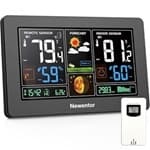What Tools Are Used to Forecast and Measure Hurricanes?
Answer at a Glance: Hurricanes are measured and forecast using various methods, including satellite imagery, aircraft reconnaissance, direct oceanic observation, and automated surface observing stations, all of which contribute to our understanding of these powerful natural phenomena.
Dig Deeper
- Satellite Measurements
- Aircraft Measurements
- Oceanic Measurements
- Automatic Surface Observing Stations
Satellite Measurements
Satellite measurements play a crucial role in hurricane forecasting. When a hurricane is far out at sea, indirect measurements are recorded using satellites. Earth-observing satellites like the Polar Satellite System (JPSS) and Geostationary Operational Environmental Satellite series (GOES-R) are indispensable for measuring a hurricane’s location, movement, and intensity. [1]
According to NASA, the JPSS are polar-orbiting satellites that measure sea surface temperatures and atmospheric temperature and moisture used to forecast storms several days in advance. The GOES satellites orbit the Earth at the same rate it spins, allowing them to follow a hurricane as it evolves. These images provide a view of a hurricane in motion. [2]
Aircraft Measurements
The National Oceanic and Atmospheric Administration (NOAA) deploys aircraft called hurricane hunters to take measurements during a hurricane.
P-3 Orion aircraft fly directly into the storm. Once inside, they can deploy several measurement tools to understand the hurricane better. [3]
Airborne Expendable BathyThermograph (AXBT) – calculate the ocean’s temperature to show how a storm passing overhead cools, mixes, or heats the ocean. [4]
Global Positioning System (GPS) dropsondes – measure wind data, humidity, pressure, and temperature as they slowly parachute toward the sea. [5]
Streamsondes – similar to dropsondes, measure wind data, humidity, pressure, and temperature, but lack a parachute and are biodegradable. [6]
Uncrewed Aircraft Systems/Drones – after deployment, the drones stay aloft for hours, gathering data at the storm’s boundary layer where the atmosphere directly interacts with the ocean’s surface. [7]
The aircraft are also equipped with Doppler radar, which gives the scientists a view of the storm in real time. [8]
The Gulfstream IV-SP (G-IV) aircraft is another key tool in hurricane research. This aircraft flies above the storm, gathering data about the steering currents influencing the hurricane’s movement. Equipped with Doppler radar and GPS dropwindsondes, it provides a comprehensive view of the storm and its surrounding conditions. [9]
Oceanic Measurements
Understanding how changes in the ocean affect a hurricane’s intensity is essential in forecasting. There are several methods scientists and researchers use to gain a better understanding and insight.
Argo Floats – deployed in the oceans worldwide to create a global data tracking network. They drift with ocean currents, measuring temperature and salinity to depths of 2,000 meters. [10]
Buoys – Observational buoys, called drifting surface buoys, are deployed in the oceans worldwide to create a global data tracking network. Monitored via satellites, they measure atmospheric pressure, mixed layer currents, salinity, sea surface temperature, winds, and waves. When pulled into a hurricane, they gather crucial data on ocean conditions. [11]
Gliders – autonomous underwater vehicles (AUVs) used to measure ocean temperature and salinity from the upper hundred meters of the ocean. [12]
Saildrones – powered by wind and solar energy, these uncrewed surface vehicles are piloted remotely to measure wind speed, wave height, temperature, pressure, and salinity. [13]
Automated Surface Observing Stations
Automated surface observing stations are the primary surface weather network for the United States and play a critical role in hurricane forecasting. [14]
References
- [1][2] NASA – “Satellites Have Drastically Changed How We Forecast Hurricanes.”
- [3][8][9] National Oceanic & Atmospheric Administration – Office of Marine and Aviation Operations – “Hurricane Hunters.”
- [4][5][6] Atlantic Oceanographic & Meteorological Laboratory – “Hurricane Observation Instruments.”
- [7] National Oceanic & Atmospheric Administration – Office of Marine and Aviation Operations – “Uncrewed Aircraft Systems.”
- [10] Atlantic Oceanographic & Meteorological Laboratory – “Argo Program.”
- [11] Atlantic Oceanographic & Meteorological Laboratory – “Global Drifter Program.”
- [12] Atlantic Oceanographic & Meteorological Laboratory – “Hurrican Glider Project.”
- [13] Atlantic Oceanographic & Meteorological Laboratory – “NOAA Saildrone Hurricane Observation.”
- [14] National Oceanic & Atmospheric Administration – National Weather Service – “NOAA Observation Systems.”

